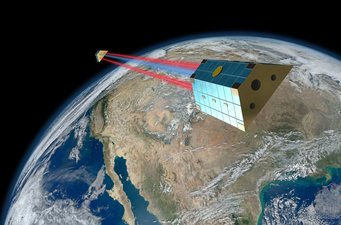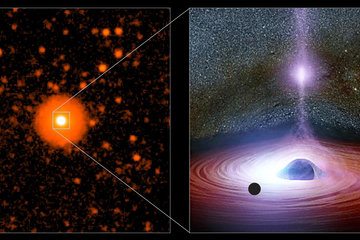Grace celebrates anniversary
20 years ago, the geodesy mission was launched, in which the Max Planck Institute for Gravitational Physics is also involved
March 17 marked the 20th anniversary of the launch of Grace into its Earth orbit. The occasion was celebrated with an event at the GFZ German Research Center for Geosciences in Potsdam. Members of the Albert Einstein Institute (AEI) in Hannover were among the guests. Until 2015, Grace monitored the Earth's gravitational field, the global water balance and indicators of global warming from its Earth orbit. Since 2018, the Grace Follow-On mission has continued the valuable measurement series. For the first time, a novel and highly precise German-US laser instrument, on the German side developed under the leadership of AEI Hannover is being used. It has proven to be reliable and will be the standard for similar missions in the future. Grace-I is the planned successor of Grace Follow-On. In addition to observing the Earth’s gravitational field, Icarus – a project monitoringanimal migrations from space – and a novel technology demonstrator are to be on board.

“20 years ago, a new phase of Earth exploration and geodesy began with the launch of Grace. On board its successor Grace Follow-On, a laser interferometer has been working in space for the first time since 2018. As the two satellites orbit Earth, a laser beam measures how the distance between them changes. These measurements provide important data for climate research. The instrument, which was developed and tested at AEI Hannover, has been working very reliably and with high precision for years,” says Gerhard Heinzel, head of the “Space Interferometry” research group at the Max Planck Institute for Gravitational Physics (Albert Einstein Institute; AEI) in Hannover. “It's clear that in the future, similar geodesy missions will use the reliable and highly precise laser technology as standard.”
The system, called Laser Ranging Interferometer (LRI), is a cooperation between Nasa and German partners, with the German contribution led by the AEI. In Germany, the LRI concept, its prototypes and technical specifications were done at the AEI. AEI researchers have been heavily involved in developing and testing the flight hardware. The development of the LRI is based on a longstanding partnership between AEI and Nasa’s Jet Propulsion Laboratory. Since the laser system has proven reliable, future missions can rely solely on the more precise laser interferometers instead of microwave interferometers.
“The data from Grace and its successors are indispensable to monitor climate change. Greenland has been losing the unimaginable amount of more than 6,000 tons of ice every second on average over the last few years,” Heinzel explains. “This can only be measured from space with missions like Grace. After the end of the current Grace Follow-On mission, these measurements must be continued.”

Planning is already underway for two satellite missions in Earth orbits that will in the future measure the Earth's gravitational field and its changes even more precisely. AEI researchers are involved in the design of the laser interferometers used in both projects:
Grace-I is a joint project of the Helmholtz Association, Nasa, DLR, and the Max Planck Society. The satellite pair will use the laser instrument LRI co-developed at AEI as the main instrument for the first time. An additional payload of the Icarus project, led by the Max Planck Institute for Behavioral Biology, which is currently on board the International Space Station, will monitor animal movements globally and continuously.
“There is initial evidence that changes in bird migration patterns are accompanied by changes in water balance measured by Grace. Combining these data sets can provide valuable further information on drought or flooding,” says Karsten Danzmann, director at AEI Hannover. “This is especially valuable in areas that are inaccessible for direct measurements, because Grace surveys the entire Earth and because the animals don't care about borders and crisis areas.”
Under the leadership of the European Space Agency Esa a “Next Generation Gravity Mission” (NGGM) is being planned in parallel, based on the same principle. Two pairs of satellites measuring simultaneously in orbits inclined to each other can significantly increase the measurement accuracy for temporal and spatial changes in the Earth's gravity field.

Additionally, the LRI on board Grace Follow-On is a further step toward measuring gravitational waves in space. This interferometer in Earth orbit uses adapted components designed for the future LISA mission. Lisa is to measure tiny length changes from the early 2030s onwards, too – but no longer in Earth orbit and also over a distance of 2.5 million kilometers.
This way, Lisa will detect gravitational waves from millions of binary star systems in our Milky Way, merging pairs of extremely massive black holes throughout the entire Universe, and other exotic objects. Unlike terrestrial gravitational-wave detectors (Geo600, Ligo, Kagra, and Virgo), LISA will observe very low frequency gravitational waves (in the range of millihertz to one hertz), opening up a whole new part of the gravitational-wave spectrum and thus new sources.
Background information
The Grace Follow-On satellite pair circles the Earth 490 kilometers above its surface. The satellites follow one another in a distance of 220 kilometers in a 90-minute orbit, which takes the satellites above the Earth’s poles. The inter-satellite distance varies over some hundreds of meters each orbit because of the flattening of the Earth. On top of these large changes are much smaller variations in the micrometer and nanometer range, caused by the local structure of Earth’s gravity field from mountain ranges, ice masses, bodies of ground water, and others.
Observing how these minuscule variations change over the course of months allows researchers to precisely detect the melting of ice sheets in Greenland and the Antarctic, rising sea levels, changing groundwater levels, droughts and floods, and to define the geoid, which is at the base of global height measurements. The novel Laser Ranging Interferometer technology could significantly increase the precision on future Grace Follow-On like missions to help those missions provide more detailed measurements of Earth’s gravity field and its changes over time.
The Grace Follow-On Laser Ranging Interferometer is the second space-borne laser interferometer with significant contributions from the Max Planck Institute for Gravitational Physics (Albert Einstein Institute) and Leibniz Universität in Hannover, Germany. The first such instrument was a 40-centimeter instrument on board the Lisa Pathfinder mission, which showed the key technologies for Lisa the future gravitational-wave observatory in space.
After its launch in 2034 Lisa will use technologies very similar to those of Grace Follow-On to measure tiny length changes over a distance of 2.5 million kilometers. Lisa will detect low-frequency gravitational waves from millions of binary stars in our Milky Way, merging supermassive black holes in the entire Universe, and from other exotic objects.
Grace Follow-On is a joint project of Nasa and German partners led by the GFZ German Research Centre for Geosciences. It is the improved successor to the successful Grace mission which operated from 2002 to 2017. The project is funded by the Federal Ministry of Education and Research under the code 03F0654B.
The LRI is a cooperation between Nasa and German partners, with the German contribution led by the AEI. In Germany, the LRI concept, its prototypes and technical specifications were done at the AEI. AEI researchers have been heavily involved in developing and testing the flight hardware. The development of the LRI is based on a longstanding partnership between AEI and Nasa’s Jet Propulsion Laboratory. Future missions can rely solely on the more precise laser interferometers instead of microwave interferometers.
The German contributions to the LRI include the entire optical system, consisting of a steering mirror, built by Hensoldt (previously Zeiss) in Oberkochen and the optical bench from SpaceTech GmbH in Immenstaad, opto-electronics from the German Aerospace Center (DLR) in Berlin-Adlershof, and electronic systems from Apcon AeroSpace & Defence in Neubiberg near Munich. SpaceTech GmbH is responsible for the industrial part of the entire German LRI contribution. The DLR Institute of Space Systems in Bremen developed and delivered calibration and testing instruments. Both satellites were built on behalf of NASA by Airbus in Friedrichshafen. Mission control for GRACE Follow-On is provided by the German Space Operations Centre (GSOC) in Oberpfaffenhofen near Munich under subcontract of GFZ.














